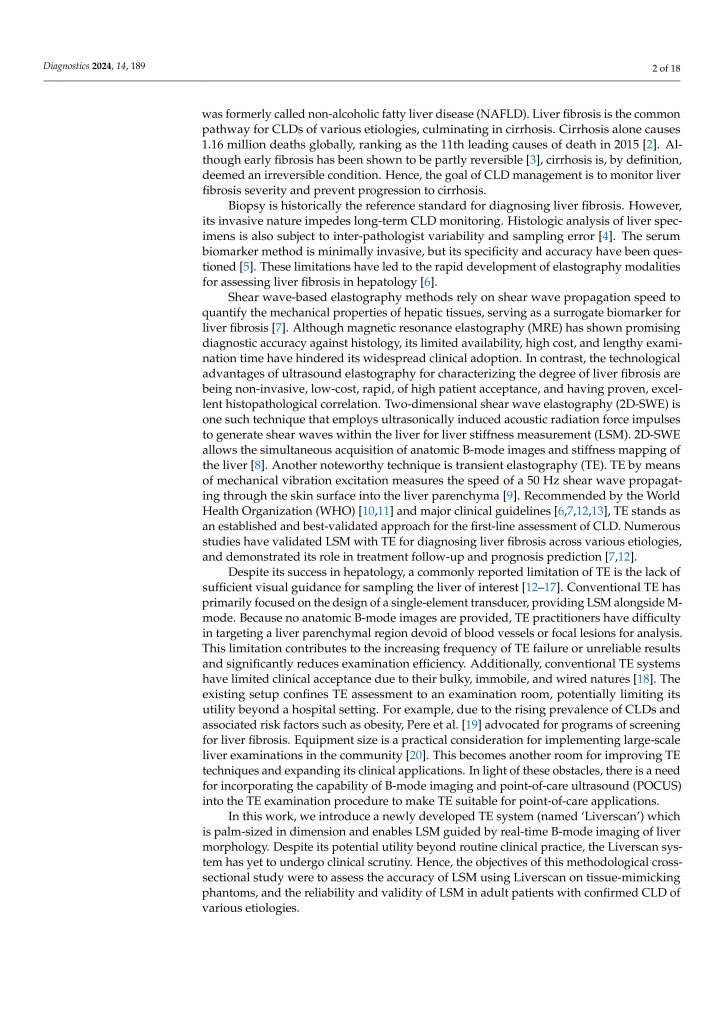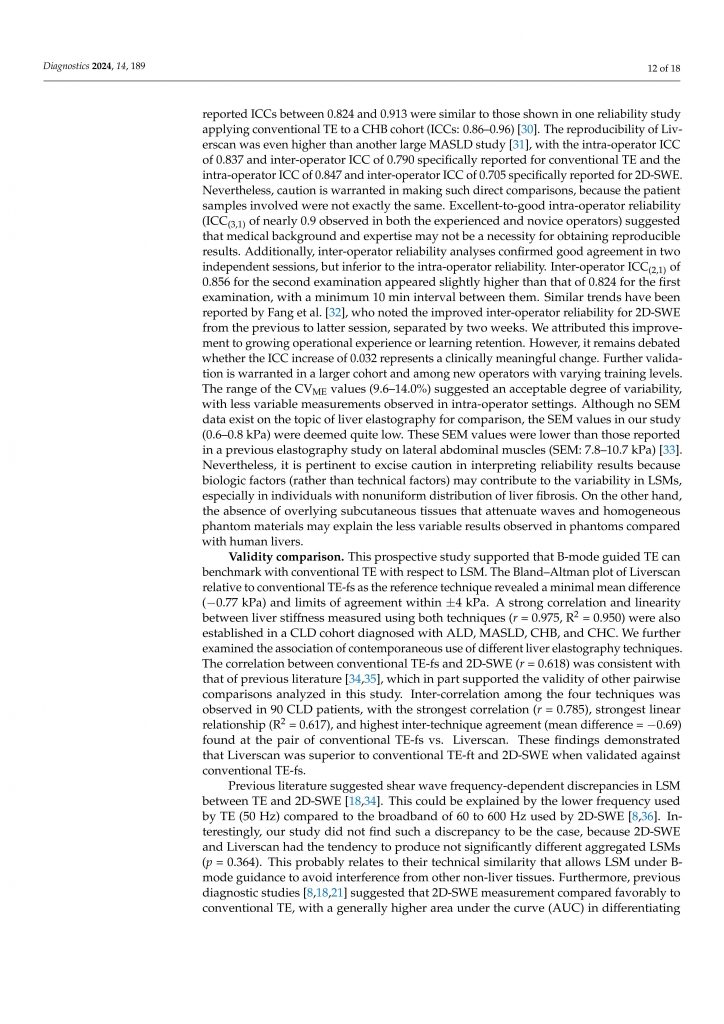
Recently, Diagnostics (IF=3.6) published a study titled “Palm-Sized Wireless Transient Elastography System with Real-Time B-Mode Ultrasound Imaging Guidance: Toward Point-of-Care Liver Fibrosis Assessment” by the team of Professor Zheng Yongping, the founding director of the Department of Biomedical Engineering at the Hong Kong Polytechnic University and the dean of the PolyU Institute of Smart Ageing (RISA), the team of Professor Zheng Minghua from the First Affiliated Hospital of Wenzhou Medical University, the Zhejiang Provincial Key Laboratory of Precision Diagnosis and Treatment of Severe Chronic Liver Disease and Translation, the team of Professor Zhou Yongjin from the School of Biomedical Engineering at Shenzhen University, and Yiling Technology. The study proved that:
The feasibility of Liverscan in assessing liver fibrosis was verified, and the results showed that Liverscan showed sufficient accuracy in the standard elastic phantom assessment, high reliability in the assessment of fibrosis in Chinese adult patients with chronic liver disease, and comparable diagnostic performance to traditional TE and 2D-SWE.




In order to serve the grassroots people more extensively, Eieling Technology will continue to work with Professor Zheng Minghua’s team, and the two parties decided to expand the scope of research to primary medical institutions. The two parties will jointly promote the screening and referral pathways for chronic liver diseases at the grassroots level, and strive to build a regional chronic disease big data platform. This model will provide more accurate diagnosis and treatment services for grassroots liver disease patients, thereby improving their quality of life. In order to ensure that the model can be replicated and promoted to benefit more patients with chronic liver disease, the two parties will first carry out regional research pilot work. Liverscan is suitable for practice in primary medical institutions due to its significant cost-effectiveness advantages.
The cooperation between Eieling Technology and Professor Zheng Minghua’s team from the First Affiliated Hospital of Wenzhou Medical University is not only a technical collaboration but also an in-depth exploration and optimization of primary medical services. We believe that with the joint efforts of both parties, this cooperation will open a new chapter for the prevention and treatment of chronic liver diseases at the primary level.
Research Abstracts
Background
Chronic liver disease (CLD) is a growing public health problem, affecting approximately 844 million people worldwide. It can be caused by viral infections, such as hepatitis B or C viruses, excessive alcohol consumption, or dietary habits leading to metabolic dysfunction-associated steatosis liver disease (MASLD). Liver fibrosis is a common pathway for CLDs of various causes, ultimately leading to cirrhosis. In 2015, cirrhosis alone caused 1.16 million deaths worldwide, ranking 11th. Although early fibrosis has been shown to be partially reversible, cirrhosis is considered an irreversible disease by definition. Therefore, the goal of CLD management is to monitor the severity of liver fibrosis and prevent progression to cirrhosis. Transient elastography (TE), recommended by the World Health Organization, is an established method to characterize liver fibrosis through liver stiffness measurement (LSM). However, technical barriers remain because conventional TE requires wired connections, is bulky, and lacks sufficient imaging guidance to accurately locate the liver.
Purpose
We demonstrated the performance of a new palm-sized TE system, Liverscan, in laboratory phantom validation and clinical evaluation that allows simultaneous B-mode imaging and liver stiffness measurement. Comparison studies with other liver elasticity imaging techniques, including conventional TE and 2D-SWE, were conducted to assess its reliability and validity in adults with various chronic liver diseases (CLDs).
Method

Result

Conclusion
The new Liverscan TE system was evaluated in a laboratory environment simulating a tissue elasticity model and in a clinical setting for Chinese adult CLD, showing adequate accuracy, operational reliability, and performance comparable to traditional TE and 2D-SWE. Livercan has optimized and innovated the traditional model, greatly improving the cost-effectiveness of the device and making it suitable for large-scale screening. Future studies will include more patients with different etiologies and use biopsy as a reference standard to explore the diagnostic accuracy of liver fibrosis staging.
Literature


















Professor Zheng Minghua

Department of Infectious Diseases, The First Affiliated Hospital of Wenzhou Medical University
Deputy Director of Department, Chief Physician, Professor, Doctor of Medicine, Doctoral Supervisor
Member of the Hepatology Branch of the Chinese Society of Research Hospitals
Member of the Fatty Liver Group of the Hepatology Branch of the Chinese Society of Research Hospitals
Member of the Professional Committee of Evidence-Based Medicine of the Chinese Medical Doctor Association
Member of the Professional Committee of Evidence-Based Medicine of the Chinese Association of Integrated Traditional Chinese and Western Medicine
Member of the Hepatology Branch of the Zhejiang Medical Association
Vice Chairman of the Hepatology Branch of Zhejiang Association of Mathematical Medicine
Global NASH Council member
GOASIA member
He has been committed to the clinical practice and research of fatty liver disease for a long time. As one of the two experts in mainland China, he participated in the drafting of two international expert consensuses on metabolic-related fatty liver disease (global and Asia-Pacific expert consensus), and also participated in the compilation of the domestic “Expert Recommendations on Standardization of Diagnosis and Treatment of Fatty Liver Disease in China (2019 Revised Edition)”.
